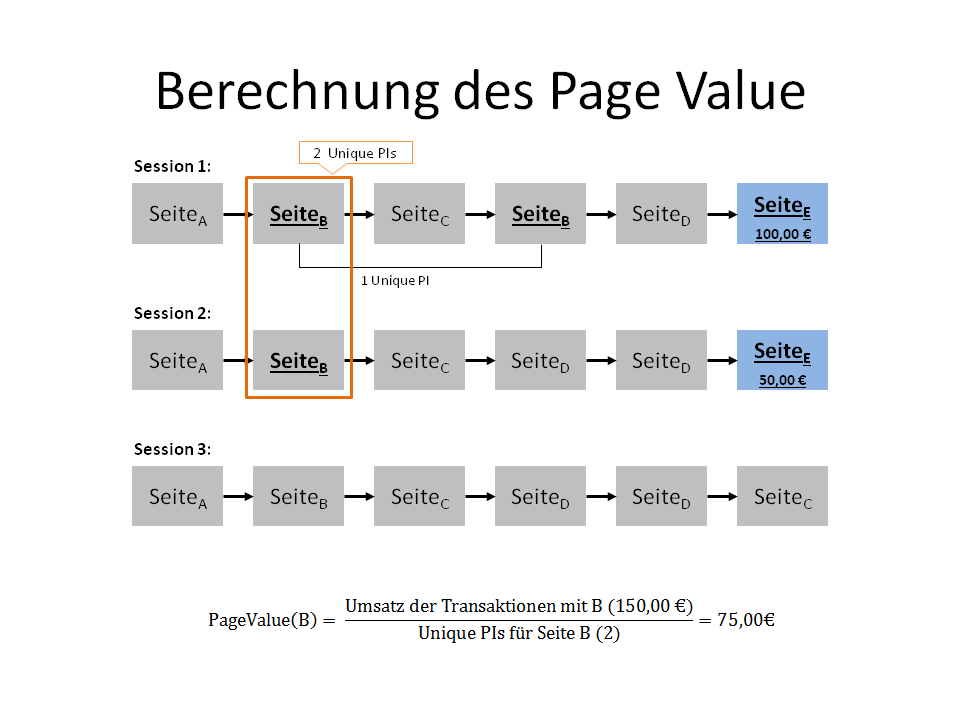Page Value
The “Page Value” is a measure of the economic relevance of page contents. It indicates to what extent certain content contributes towards the success of the website. If a page is viewed particularly often by visitors who then carry out transactions during this visit, then this page will receive a high page value. As an online retailer, it is important to not just evaluate pages in regard to their popularity, that is, using page impressions, views per visit, entries, exits and bounce rates. In eCommerce, economic success is what counts. Particular attention should therefore be paid to those pages which are accessed a lot or have a high number of visitors, but have a lower page value. Or vice-versa, pages with few visits, but which have a relatively high page value. Therefore, the page value is very helpful as an indicator for pages which increase conversions and sales. The value is calculated as follows: The sales of all transactions in the selected period is divided by the unique number of page impressions or the number of visits for each page.
The following graphic illustrates the principle:

Accordingly, the page value shows which websites lead to sales. If a page is not found in any visit where something was bought, then the page value for this page is zero. If no sales are recorded in general, then the page value for all pages is zero. By nature, the value for the pages of the checkout process and generally for the homepage are particularly high. Here, you should consider that pages about the company or in the area of Customer Service have a very low page value. What is interesting and notable are those cases where the visitor numbers for product or category contents do not correlate with the page value, that is, many visits and low page value or few visits and high page value. Just as interesting is the comparison of the page values with the product events and conversions, especially, the ‘Seen’ number and the ratios of ‘Product page to basket’ or ‘Product page to purchase’ in the eCommerce Reports.
Accordingly, one should be very careful when removing items from the product range or changing them, which, when viewed by themselves, generate low sales, but have a high page value and thus appear to play an important role in the evaluation process. But beware! Unlike with marketing attribution, that is, the allocation of conversions and sales to media and campaigns, with page value sales are not allotted. While the page value is calculated from the generated sales, its sum does not correspond to the overall turnover across all pages. For this reason, no sum will be shown in the respective reports for the page value. The page value is to be seen more as a visitor count weighted with sales.
In the etracker application you will find the key figure in the page report of etracker Analytics under Web Analytics → Basic Reports.
Area Value
The “Area Value”, similar to the page value, is a measure of the economic relevance of page contents. If a website area is viewed particularly often by visitors who then carry out transactions during this visit, then this area will receive a high area value. Therefore, the area value indicates to what extent certain content contributes towards the success of the website. Areas with a high area value have a greater effect than those with a low value. Unlike the “Product Performance Reports”, this does not count if a product was viewed from the area or if it was placed in the basket and ordered, but if an area was viewed by buyers. This way, the page and area values clearly show the economic influence of content beyond the product detail pages. The area value is calculated as follows: The sales from all transactions in the selected period is divided by the unique number of page impressions or the number of visits for each area.
Caution: Unlike with marketing attribution, that is, the allocation of conversions and sales to media and campaigns, with area value sales are not allotted. While the area value is calculated from the generated sales, its sum does not correspond to the overall turnover across all areas. For this reason, no sum will be shown in the respective reports for the area value. The area value is to be seen more as a visitor count weighted with sales.
In exactly the same way, with multiple area levels, the values of subareas are not summed up to upper area levels. Upper sections are only assigned a value if unique pages are also assigned to them, for example, overview pages. In the etracker application you will find the key figure in the area report of etracker Analytics under Web Analytics → Basic Reports.
Click Paths
Along with the question of which pages are the most popular or relevant, it can be revealing to look at the paths the visitors take. The progression from page to page by visitors is known as the clickpath. Inside the clickpath reports, you will be shown the visitor flow on your website both visually and in table form. Here, select the desired page from the table from which the onward “behavioural flow” should be viewed. Using the visual Sankey diagram from the viewed page, you can optionally analyse the top 5 or top 10 pages which are viewed directly or opened afterwards. In addition, you have the option to specifically examine an individual section by clicking on one of the following opened pages.